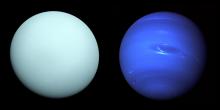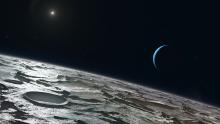Listen to today's episode of StarDate on the web the same day it airs in high-quality streaming audio without any extra ads or announcements. Choose a $8 one-month pass, or listen every day for a year for just $30.
You are here
Neptune Opposition II
Earth’s weather is powered by the Sun, which bathes our planet with energy. But the Sun’s most remote planet powers its own weather. It radiates more than twice as much energy into space as it receives from the Sun. That creates big storms and the fastest winds on any planet in the solar system.
Neptune is the eighth planet from the Sun, and the fourth-largest planet — almost four times wider than Earth. A dollop of methane in its upper atmosphere absorbs red light, making the planet look blue.
Heat generated deep inside Neptune radiates out into the planet’s atmosphere, stirring up some interesting weather.
Over the last three decades, for example, astronomers have seen several giant “dark spots.” The oval features are thousands of miles wide, and they last for years. They appear to be swirling storms that are fairly deep in the atmosphere.
Neptune also produces bands of winds that circle the planet. These jet streams blow at hundreds of miles per hour. The fastest winds yet seen raced along at 1200 miles per hour — about five times faster than anything ever measured on Earth.
The windy planet Neptune is at its best for the year this week. It rises at sunset and is in view all night. It’s low in the southeast as night falls, near the eastern edge of Aquarius. Despite its great size, it’s so far away that you need good binoculars or a telescope to find it.
More about Neptune tomorrow.
Script by Damond Benningfield






